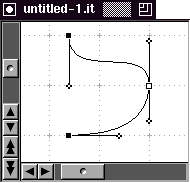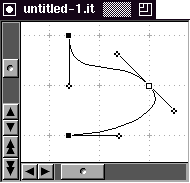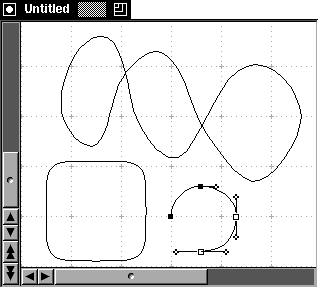Mon Apr 20 14:15:09 1998
- Image 1 shows the new tools in the ToolkIt.
- Creating a rectangle.
- The same, but with SHIFT pressed, the object created will have identical sides (the rectangle will be a square; the ellipse a circle).
- Resizing a rectangle.
- With CONTROL pressed, resizing is done from the center of the object. CONTROL will also work during creation (SHIFT during resize has not yet been implemented).
Ellipses function fully analoguous to rectangles, but I don't dare to show them yet, since they do not look like ellipses yet :-) (The assumption that ax == ay == 0 in the curves is wrong.)
 |
 |
 |
 |
 |
| 1 | 2 | 3 | 4 | 5 |
Thu Apr 16 00:50:05 1998
One notable addition today is that Illustrate It! has had the first revision of its file format. Since the file format mostly is a (human readable) object archive, this revision is nothing more than an archiving version bump of a single class (the `closed' attribute of a Shape path, if you really want to know). However, It! has been shown to correctly write the new version (duh!), and correctly read both the old and the new version, so the machinery underlying the support of an evolving file format has been shown to work. I intend to maintain this level of format support throughout It! development: at any time you can use It! for something real, and be certain that future versions will be able to read your files. (It's an intention, not a promise. Fingers crossed; no warranty.)

Tue Apr 14 15:04:00 1998
- A path with three points (and two curve segments).
- The rightmost control point is being dragged, thereby modifying the two control points of the selected point. Both the original path and the path resulting from the modification are shown.
- After releasing the mouse, the path has been modified. Fully un-/re-doable, of course.
 |
 |
 |
| 1 | 2 | 3 |
Sat Apr 11 01:35:30 1998
- Files can be saved and loaded. Specify them on the command line to load them (or to name a new file), and click the File/Save menu item to save. The save format is textual and readable, though not very pleasing to the eye.
- Exporting a file foo.it creates a file foo.eps.
- Starting It! without any file arguments creates a new document untitled-xxx.it, where xxx is some number to make the filename unique.
Fri Mar 20 01:32:50 1998
- The path tool can create bezier curves. Image (1) shows three such curves; the circle-like curve is selected; two of its points are selected; the other two are not. Selected points can be dragged; control points can't just yet.
- Image (2) shows what ghostview thinks of the EPS file created by exporting the document shown in image (1). The resemblance is stunning :-)
- EPS exporting writes to the file
it-out.epsin the current directory instead of tostderr. - Lots of fixes, great and small.
 |
 |
| 1 | 2 |
Mon Mar 16 01:48:11 1998
 |
 |
| 1 | 2 |